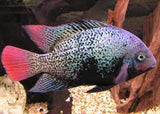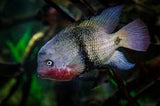Please contact store for availability as this item is not available all year round.
Black belt cichlid - Vieja maculicauda
Scientific name: Vieja maculicauda
Common name: Black belt cichlid
Family: Cichlidae
Usual size in fish tanks: 20 - 30 cm (7.87 - 11.81 inch)
014
Recommended pH range for the species: 7 - 8
Recommended water hardness (dGH): 12 - 20°N (214.29 - 357.14ppm)
0°C 32°F30°C 86°F
Recommended temperature: 23 - 27 °C (73.4 - 80.6°F)
The way how these fish reproduce: Spawning
Where the species comes from: Central America
Temperament to its own species: peaceful
Temperament toward other fish species: aggressive to smaller
Usual place in the tank: Middle levels
Origin
The Black Belt Cichlid can be found throughout most areas of Central America, particularly along the western waterways. They inhabit slow moving waters so water flow in the aquarium is not a major requirement but to keep oxygen levels up it is advised to aim the filter outlets towards the water surface to increase gaseous exchange.
Lifespan
7-8 years.
Short description
This is not a very demanding fish and can live in a wide range of water parameters but keeping the pH around the neutral level (7.0), will provide these fish with the best conditions to thrive and live a long life. They are quite happy in a simple aquarium set up so use sand for the substrate as they do like to burrow and adding some rocks or wood is sufficient.
They do not like bright lighting so keep the level dimmed, the use of floating plants will help with this.
Like most of the larger cichlids, they can have an aggressive temperament, this is heightened during spawning times and they are extremely protective towards their fry. Only keep the Black Belt Cichlid with species of a similar size, smaller fish will be seen as a food source.
These are not the most difficult fish to keep but inexperienced keepers may struggle with the aggression so be aware of this before purchasing.
Feeding
Feed them brine shrimp, worms, mosquito larvae, vegetables, granules once or twice a day. They are often classed as herbivorous but do require meaty foods added to their diet.
Sexing
Females are darker than males. Males usually have head hump.
Breeding
Black belt cichlids breed in captivity relatively easy. They’re egg-layers; eggs are laid on a previously cleaned rock. After 2-3 days the fry should hatch and will be free swimming a few days later. The parent fish will move the fry around the aquarium and pits will be made in the substrate to provide a nest. The fry should be fed Artemia salina.






